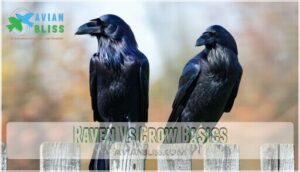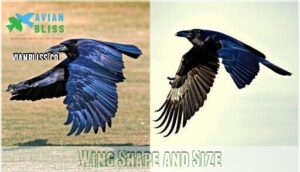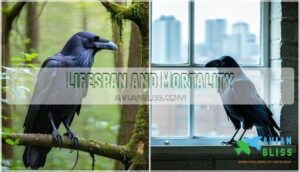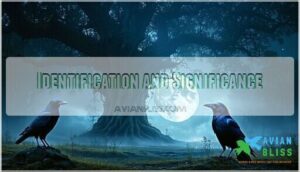This site is supported by our readers. We may earn a commission, at no cost to you, if you purchase through links.
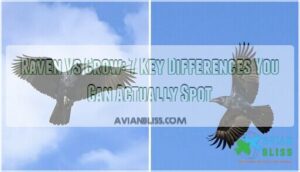 You’ll spot the raven vs crow difference instantly once you know the tricks.
You’ll spot the raven vs crow difference instantly once you know the tricks.
Ravens are the heavyweights—nearly twice as big with wedge-shaped tails that look like diamonds in flight.
They’ve got shaggy throat feathers that make them look disheveled, plus they croak like they’ve been smoking for decades.
Crows are the neat freaks with fan-shaped tails, sleek feathers, and that classic "caw-caw" sound everyone knows.
Ravens soar like mini-eagles, doing barrel rolls for fun, while crows fly straight with steady wingbeats.
Size matters here—ravens stretch 24-27 inches compared to crows at 17-20 inches.
But there’s more to these clever birds than meets the eye.
Table Of Contents
- Key Takeaways
- Raven Vs Crow Basics
- Flight Patterns Compared
- Intelligence and Behavior
- Diet and Foraging Habits
- Habitat and Distribution
- Lifespan and Mortality
- Identification and Significance
- Frequently Asked Questions (FAQs)
- Is there a difference between a crow and a raven?
- What US states have ravens?
- What is a flock of ravens called?
- Do ravens hop or walk?
- What is the difference between a raven and a crow?
- Are Ravens smarter than crows?
- Are crows more aggressive than ravens?
- Are ravens crows?
- What is the difference between a crow and a raven?
- Are ravens as smart as crows?
- Conclusion
Key Takeaways
- You’ll instantly recognize ravens by their massive size – they’re nearly twice as big as crows at 24-27 inches compared to crows’ 17 inches, with thick curved beaks and shaggy throat feathers that puff up when they call.
- You can spot the difference in flight by watching their tails – ravens display distinctive wedge-shaped tails that look like diamonds, while crows show fan-shaped tails that spread wide.
- You’ll hear them before you see them – ravens produce deep, throaty croaks like they’ve been smoking for decades, while crows make the classic sharp "caw-caw" sounds everyone knows.
- You’ll notice completely different flying styles – ravens soar effortlessly like mini-eagles and perform aerial acrobatics including barrel rolls, while crows fly straight with steady wingbeats and stick to no-nonsense flight patterns.
Raven Vs Crow Basics
You’ve probably seen these black birds hopping around your yard and wondered if that’s a crow or a raven perched on your fence.
While they might look nearly identical at first glance, ravens and crows have distinct differences that become obvious once you know what to look for, particularly in terms of complete concepts.
Physical Characteristics
Most people can’t tell ravens from crows at first glance, but you’ll spot distinct physical differences once you know what to look for.
Ravens are nature’s heavyweights, measuring 24-27 inches compared to crows’ 17-inch frame, with thicker beaks designed for tougher tasks.
Ravens dwarf their crow cousins—imagine a hawk next to a sparrow.
| Feature | Raven | Crow |
|---|---|---|
| Size Comparison | 24-27 inches, 40oz | 17 inches, 20oz |
| Beak Morphology | Thick, curved "Swiss Army knife" | Straight, pointed blade |
| Tail Shape | Wedge-shaped in flight | Fan-shaped spread |
Ravens flaunt shaggy hackle feathers around their throats that puff dramatically when calling, while crows sport sleek neck plumage.
The feather iridescence differs too—ravens shimmer with glossy greens and blues, whereas crows display matte purple-blue hints.
These birds also exhibit different social structures and interactions.
Size and Shape Differences
When you spot these birds side by side, you’ll notice ravens appear nearly 50% larger than crows—like comparing a hawk to a robin.
Ravens measure 24-27 inches with triangular head shapes, while crows average 17 inches with more pointed features.
| Feature | Raven | Crow |
|---|---|---|
| Size | 24-27 inches, 1.5-3.5 lbs | 17 inches, 0.75-1.5 lbs |
| Tail Shape | Wedge-shaped | Fan-shaped |
| Beak Curvature | Large, curved | Shorter, straighter |
| Head Shape | Triangular | More pointed |
| Wingspan | 47 inches | 39 inches |
Appearance and Feather Texture
Beyond their size differences, you’ll notice distinct feather textures when examining these corvids closely.
Ravens sport shaggy throat hackles that puff dramatically during calls, while crows maintain smoother neck feathering.
Their plumage also shows different iridescent qualities under sunlight.
| Feature | Ravens | Crows |
|---|---|---|
| Throat Feathers | Shaggy hackles that puff up | Smooth, sleek feathers |
| Plumage Iridescence | Glossy greens and blues | Matte with purple-blue hints |
| Beak Curvature | Thick, curved like Swiss Army knife | Slimmer, straighter profile |
Flight Patterns Compared
You can spot these birds from a distance by watching how they move through the air.
Ravens soar like hawks on invisible currents while crows flap their wings steadily like they’re late for an important meeting.
Wing Shape and Size
You’ll notice ravens have substantially larger wings with a 47-inch wingspan compared to crows’ 39 inches.
This wing area difference creates better flight efficiency through improved aspect ratio and aerodynamics. Ravens’ feather structure supports extended soaring, while crows’ smaller wingspan requires more frequent flapping.
The size difference becomes obvious when comparing their wing proportions—ravens look almost hawk-like in flight.
Flight Styles and Behaviors
Ravens perform aerial acrobatics like somersaults and barrel rolls, especially during mating displays, while crows stick to straightforward, no-nonsense flight patterns.
You’ll notice ravens riding thermals effortlessly with minimal flapping frequency, whereas crows maintain steady wingbeats throughout their journey.
During group flight, crows form massive winter flocks while ravens prefer intimate family gatherings.
Ravens also use wing adjustments for aerodynamics to optimize their flight patterns and make aerodynamics adjustments.
Soaring and Gliding Abilities
You’ll spot ravens mastering thermal riding like skilled pilots, using rising warm air to soar effortlessly for minutes without flapping.
Their superior wing morphology enables impressive gliding duration and aerial acrobatics—including somersaults during breeding season.
Crows lack this energy efficiency, relying on constant wing beats instead of graceful gliding for raven vs crow identification purposes.
Intelligence and Behavior
You’ll discover that both ravens and crows rank among nature’s smartest birds, but they use their intelligence in distinctly different ways.
Ravens excel at complex problem-solving and tool use, while crows dominate social learning and face recognition.
Problem-Solving Abilities
Both birds showcase remarkable intelligence comparison, but their cognitive skills differ in fascinating ways.
Ravens excel at tool use and innovation, bending wires into hooks and dropping stones to raise water levels.
Crows master social learning, remembering human faces for years and teaching offspring survival tricks.
Memory capacity in both species rivals great apes, with ravens planning hours ahead and crows solving multi-step puzzles. Crows also exhibit a surprising understanding of zero, surpassing even small children in this numerical concept.
Social Structure and Interaction
When you spot ravens, you’ll notice they prefer solitude or stick with their immediate family unit.
These birds maintain tight-knit family dynamics, typically traveling in pairs or small groups of three to four.
Crows, however, are the ultimate social butterflies, forming massive flocks that can number in the thousands during winter roosts.
Their cooperative behavior includes sharing information about food sources and predators through complex social hierarchy systems.
Dominant birds establish roles to reduce conflict, using submission tactics to maintain order, showcasing a clear social hierarchy.
Communication Styles and Vocalizations
You’ll hear the difference between raven vocalizations and crow cawing immediately.
Ravens produce deep, throaty croaks with over 116 distinct sounds, including knocking and gurgling noises that showcase their mimicry abilities.
Crows stick to sharper "caw-caw-caw" alarm calls, though they possess impressive regional dialects.
Both species can imitate human speech and environmental sounds, making bird calls identification trickier than expected.
Some enthusiasts even practice raven calling, hoping to bridge the communication gap, and understand the complex behaviors of these intelligent birds.
Diet and Foraging Habits
You might notice that ravens and crows seem to eat everything, but they actually have pretty different dining preferences.
Ravens are the picky eaters who prefer meat and carrion, while crows are the opportunistic buffet-goers who’ll sample whatever’s available.
Raven Diet and Foraging
You’ll find ravens aren’t picky eaters—they’re nature’s ultimate opportunists. Their raven diet includes everything from carrion consumption to active prey selection of small mammals and bird eggs.
Ravens excel at tool use, manipulating sticks to extract insects or dropping shellfish from heights. Their scavenging habits involve following predators for leftovers, while their impressive food caching behavior helps them survive lean times through strategic storage.
To stimulate these natural behaviors, consider offering ravens stimulating foraging options.
Crow Diet and Foraging
Crows aren’t picky eaters—they’re opportunistic omnivores with impressive dietary adaptations.
You’ll notice their foraging techniques shift with urban food sources and seasonal variations.
Their crow diet includes:
- Plant matter – seeds, grains, fruits (75% of diet)
- Animal protein – insects, worms, small mammals (25% of diet)
- Human scraps – garbage, fast food leftovers in cities
These feeding habits create significant agricultural impact when they raid crops.
To supplement their diet, consider using a crow bird feeder.
Hunting and Scavenging Strategies
Ravens and crows employ vastly different hunting strategies that’ll help you distinguish these clever corvids.
Ravens excel at cooperative hunting, working in pairs to distract predators while raiding nests or carcasses. They show remarkable tool use, fishing with sticks and solving complex problems for carrion preference rewards.
Crows favor urban scavenging, methodically picking through trash and using roads to crack nuts. Both species demonstrate sophisticated prey selection, but ravens coordinate elaborate heists while crows rely on individual cunning and adaptability.
Some birds exhibit unique ground feeding behaviors, which can differ substantially between species.
Habitat and Distribution
You’ll notice these two black birds prefer completely different neighborhoods, which makes identification much easier once you know where to look.
Ravens stick to wild, mountainous areas and forests, while crows have mastered the art of city living and can thrive just about anywhere humans have settled.
Raven Habitats and Elevations
Ravens thrive at high elevations where most birds struggle, making Mountain Habitats their domain.
You’ll spot Desert Ravens across southwestern landscapes, while Arctic Distribution extends their range into Alaska’s frozen wilderness.
These adaptable corvids excel at Cliff Nesting, building homes on rocky ledges up to 10,000 feet.
Unlike their crow cousins, ravens push Elevation Limits higher, preferring remote wilderness over populated areas.
Crow Habitats and Adaptability
You’ll spot crows everywhere humans live – from bustling Urban Crow Havens in downtown areas to quiet suburban neighborhoods.
These adaptable birds thrive in Farmland Adaptations, feasting on crops and insects.
Coastal Crow Life offers seafood buffets, while parks provide perfect Crow Nesting spots.
Unlike ravens preferring wilderness, Corvus brachyrhynchos masters urban adaptation despite Habitat Loss, making crow habitat incredibly diverse through clever crow behavior.
Geographic Range and Migration
Understanding where you’ll spot these birds reveals fascinating patterns.
Ravens dominate mountainous regions and northern territories, while crows prefer human-populated areas across North America.
Here’s their geographic breakdown:
- Raven Distribution spans Arctic tundra to desert cliffs
- Crow Migration involves 86% of eastern populations moving south
- Habitat Overlap occurs mainly in northern and western regions
- Range Expansion follows urbanization and climate impact trends
Lifespan and Mortality
You’ll find that ravens typically outlive crows by a significant margin, with ravens reaching 20-25 years in the wild compared to crows’ more modest 7-10 year lifespan.
This longevity difference stems from ravens’ larger size, stronger immune systems, and their preference for less populated areas where they face fewer human-related dangers than their city-dwelling crow cousins.
Raven Lifespan and Survival
In the wild, ravens typically live 10–15 years, though some reach 22 years.
First-year survival sits around 47%, jumping to 81% by year two.
Predator impact from owls and martens threatens eggs and chicks.
Disease vulnerability, habitat changes, and food scarcity create additional challenges.
Human influence brings both risks—like vehicle collisions and poisoning—and benefits through supplemental feeding that boosts survival rates.
Crow Lifespan and Mortality
Crows face a tougher survival game than their raven cousins.
Most crow species live just 7-8 years in the wild, though some lucky individuals reach 15-20 years.
Urban dangers like vehicle strikes and pollution take their toll, while West Nile Virus has caused massive die-offs—sometimes claiming 90% of local populations.
Disease impact from avian flu and predation threats from hawks and owls create constant mortality causes that limit crow longevity despite their street-smart adaptability.
Factors Affecting Lifespan and Mortality
Several factors determine whether ravens and crows reach their maximum lifespan potential.
Predator threats like hawks and owls pose greater risks to smaller crows than robust ravens.
Disease impact affects both species, but habitat loss hits crows harder since they’re more urban-dependent.
Food scarcity during harsh winters challenges survival, while human influence through vehicle strikes and poisoning creates ongoing mortality risks for both corvids, facing mortality risks.
Identification and Significance
Now that you can tell these remarkable birds apart, you’ll discover they’ve fascinated humans for thousands of years across every culture imaginable.
Both ravens and crows appear in countless myths, legends, and folklore, often carrying messages between worlds or serving as symbols of wisdom, death, and transformation.
Identifying Ravens and Crows
Now you can spot the difference between these corvids with confidence. Start with size comparison – ravens are nearly 50% larger than crows.
Check tail shapes during flight: ravens display wedge-shaped tails while crows show fan-shaped spreads. Notice beak differences – ravens sport thick, curved bills versus crows’ straighter beaks.
Watch for feather iridescence, as raven plumage shows glossy greens and blues. Listen for vocal cues – ravens croak deeply while crows produce sharp caws.
A reliable guide aids accurate ID, helping you with accurate identification.
Raven Mythology and Symbolism
Ravens carry profound meaning across cultures, serving as messengers between worlds and symbols of transformation.
Norse mythology features Odin’s ravens Huginn and Muninn, representing thought and memory.
Native American traditions celebrate ravens as creators of light, bringing sun and stars to humanity.
These Raven Deities embody wisdom and trickery.
Raven Folklore positions them as shape-shifters and prophets, while Cultural Significance varies from divine messengers to death omens, making raven symbolism richly complex.
Crow Mythology and Symbolism
Throughout history, crow symbolism has danced between darkness and light, embodying both wisdom and warning.
These black-feathered messengers appear in folklore motifs as divine guides and death omens.
Celtic traditions linked crows to war goddesses, while Native Americans saw them as transformative spirits.
Their cultural significance spans continents – from Greek augury to Hindu ancestral messages.
In literary symbolism, crows represent cunning intelligence and spiritual protection, making omen interpretation deeply personal.
Frequently Asked Questions (FAQs)
Is there a difference between a crow and a raven?
Like twin shadows cast by different trees, these black-winged cousins share the sky but tell distinct stories.
You’ll spot ravens by their wedge-shaped tails, larger size, and deeper croaks, while crows sport fan-shaped tails and familiar caws.
What US states have ravens?
You’ll find ravens across western states like Alaska, Washington, Oregon, California, Nevada, Utah, Colorado, Wyoming, Montana, Idaho, Arizona, and New Mexico.
Plus parts of northern states like Maine, New Hampshire, Vermont, and Minnesota.
What is a flock of ravens called?
Like Edgar Allan Poe’s famous birds, you’ll find ravens gathering in groups called "unkindnesses" or "conspiracies."
These dramatic terms fit their mysterious nature perfectly, though they typically stick to pairs or small family groups year-round, often forming what could be described as a "conspiracies".
Do ravens hop or walk?
You’ll spot ravens doing both! They hop when moving quickly or on rough terrain, but they’ll walk with a confident strut when casually foraging on smooth ground.
What is the difference between a raven and a crow?
Ravens and crows differ substantially in size, with ravens being nearly twice as large.
You’ll notice ravens have wedge-shaped tails, curved beaks, and shaggy throat feathers, while crows sport fan-shaped tails and straighter beaks.
Are Ravens smarter than crows?
Both birds display remarkable intelligence, but crows might edge out ravens slightly in problem-solving tests.
You’ll find crows excel at remembering human faces and adapting to urban environments, while ravens showcase impressive tool-making skills and complex social coordination behaviors.
Are crows more aggressive than ravens?
Like neighborhood bullies competing for territory, crows typically show more aggressive behavior than ravens.
You’ll notice crows mobbing threats in large groups, while ravens prefer avoiding confrontations through their intelligence and size advantage.
Are ravens crows?
No, ravens aren’t crows – they’re distinct species from the same corvid family.
You’ll notice ravens are much larger, with wedge-shaped tails and deeper croaks, while crows are smaller with fan-shaped tails and harsh caws.
What is the difference between a crow and a raven?
Did you know ravens weigh nearly double what crows do?
You’ll spot the difference easily: ravens are larger with wedge-shaped tails, curved beaks, and deeper croaking calls, while crows have fan-shaped tails and harsh caws.
Are ravens as smart as crows?
Both species show remarkable intelligence comparable to great apes. Ravens excel at tool-making and complex problem-solving, while crows remember human faces for years and adapt brilliantly to new environments.
Conclusion
Next time you’re outside wondering about that black bird overhead, you’ll know exactly what you’re looking at.
The raven vs crow debate becomes simple once you spot the telltale signs: size, tail shape, throat feathers, and flight patterns.
Ravens are the acrobatic show-offs with their wedge tails and rough croaks, while crows stick to their fan-shaped tails and familiar caws.
These remarkable corvids have mastered different survival strategies, making identification easier than you’d expect when you know what to watch for, using their unique characteristics to thrive.
- http://naturemappingfoundation.org/natmap/facts/crow_vs_raven.html
- https://animals.howstuffworks.com/birds/american-crows-and-ravens-whats-difference.htm
- https://www.massaudubon.org/nature-wildlife/birds/crows-vs-ravens-vs-grackles
- https://en.wikipedia.org/wiki/Common_raven
- https://www.canr.msu.edu/outreach/wildlife-crows.pdf

